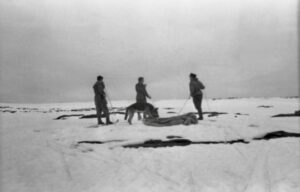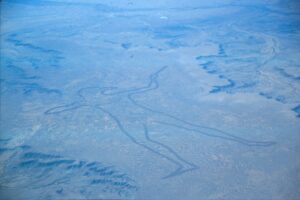Where do machines go to die? Much like humans, some of the vehicles built to make our lives easier also have final resting places. These typically abandoned and derelict cemeteries have become niche visitor sites in recent years. Urban explorers and transport history buffs make pilgrimages to those spots where fleets of planes, shipwrecks, and trains slowly rust away.
The boneyards of the western U.S.
A boneyard is a massive storage facility for grounded aircraft. The United States has some of the largest boneyards in the world, deep in its deserts. These dry, flat areas provide ideal conditions for preserving aircraft, including minimal corrosion, low humidity, and consistent temperatures.
Workers usually paint the planes in two layers of black paint followed by a final white coat to slow decay from the elements. The white keeps the planes from becoming too hot under the desert sun.

Retired aircraft in the boneyard at Davis-Monthan Air Force Base. Photo: Purplexsu/Shutterstock
The planes have one of two fates in these places: permanent decommission or temporary grounding. During the Covid pandemic, the boneyards became full of temporarily grounded planes. After the travel industry started picking up again, many of them returned to the skies.
On the other end, hundreds or thousands of commercial and military aircraft have baked in the desert sun for decades. Their engines and weaponry have been removed, fuel drained, and sometimes wings cut. Others have been completely scrapped for parts.
The Davis-Monthan Air Force Base in Arizona, the world’s largest boneyard, houses American military planes from all eras. Across 10 sq km of desert, over 4,400 aircraft from World War II, Vietnam, and the Gulf Wars slowly deteriorate. Plane junkies formerly delighted at the collection of Douglas DC-9s, A-10 Thunderbolts, F-14 Tomcats, a range of Boeings, and B-52s. They used to run bus tours through the base, but these have recently stopped.
The world’s largest commercial boneyard, Pinal Airpark in Tucson remains accessible. It hosts over 300 aircraft from major airlines including Jet Blue, Delta, United, and Cathay Pacific. You can arrange tours to view the airliners up close.
Smaller boneyards including the Roswell International Air Center and the Mojave Air and Space Port. These not only store retired planes. Aerospace companies use the runways to conduct tests and to experiment with prototype aircraft. Some companies even use it in air racing competitions.
Uyuni train cemetery
Not far from the Salar de Uyuni in southwest Bolivia — the world’s largest salt flat — stands a cemetery for the country’s antique locomotives. Just three kilometers from the local Uyuni train station, rusty train carriages, wagons, and parts litter the sand, tetanus-ridden and graffiti’d. It takes the onlooker back to a time when Bolivia held immense economic promise.

Train cemetery in Bolivia. Photo: flocu/Shutterstock
In the late 19th century, British engineers built a vast railway to carry Bolivia’s main exports — nitrates, lithium, and silver — to the Pacific. Plans were afoot to extend this system to connect major cities.
However, the country fell on hard times. Geopolitics, the collapse of the mineral industry, and circumstances in the war-torn 1940s eventually led to the railway’s demise.
Since it is so close to the salt pans, the trains corroded quickly. But this has not stopped visitors from clambering over and into the cars. This is all legal, by the way. No official body regulates the site.
Many of the trains came from the UK, including a powerful locomotive from Manchester. The oldest cars came from America and were built in the early 1900s.
Mo’ynoq Ship Graveyard
We all grieve the ecological disaster that is the Aral Sea. Once the world’s fourth-largest lake with a rich fishing industry, the Aral Sea is now a shallow puddle and a fraction of its former size. In the 1960s, the Soviets made the irreparable mistake of diverting the only two rivers that fed the Aral Sea elsewhere to irrigate cotton farms.
By the 1990s, the Aral’s volume had decreased by 80%. Many locals left, and those who stayed behind often suffered chronic illness from chemical runoff and toxic dust from Soviet activity.

Rusty boats near Mo’ynoq, in the former Aral Sea. Photo: Milosz Maslanka/Shutterstock
Rusted boats lie scattered across what are now desert sands. The sea became a graveyard for these abandoned fishing vessels. Wildlife wanders past and uses the structures for shade from the searing sun.
The ghost town of Mo’ynoq has a single-room museum, which displays the Aral Sea’s glory days. Tourism has actually started to pick up, and not just to see the ships. To everyone’s surprise, sad little isolated Mo’ynoq became a perfect spot for Central Asia’s largest electronic dance music celebration, the Stihia Festival.
World War II planes in Papua New Guinea
In the Pacific Theater during World War II, the lush tropical jungles became graves not just for many American and Japanese soldiers but also for the planes in which they flew. The remains of bombers and reconnaissance aircraft still lie deep in the jungle or on the sea floor of Papua New Guinea.

World War II plane wreck in Papua New Guinea. Photo: Jake Magnus/Shutterstock
One such famous plane wreck is that of Japanese admiral Yamamoto. After the Americans caught wind of his plans to fly to the Solomon Islands, they shot down his Mitsubishi G4M bomber. It crashed on the island of Bougainville in 1943. The wreck serves as a memorial for Japanese officials visiting the area.
Another famous wreck, nicknamed Black Jack, lies on the sea floor near Cape Vogel. Three Australians accidentally discovered it while diving 45m down. It remains in relatively good condition.
The plane foundered after a series of mishaps during the flight. It got caught in a bad storm and one engine failed. Then it ran out of fuel. Luckily, the pilots escaped. Another plane wreck in the sea is a Japanese Mitsubishi Zero, a fighter plane found in Kimbe Bay, New Britain.
Two further aircraft lie on Rabaul Island, taken over by bush: a USAAF B-25H Mitchell and a Royal New Zealand Air Force PV-1 Ventura. And in Kavieng, New Ireland, a floatplane nicknamed Deep Pete lies 40m down.
Red Star Train Graveyard
The Istvántelek Train Yard, aka the Red Star Train Graveyard, houses over 100 retired locomotives on the outskirts of Budapest. It used to serve as a workshop for repairs to trains of the national railway. While it may look like any old warehouse, with broken glass and rusting tools, it was once the largest building in Hungary’s capital.
Much like walking through time, you will find some impressive, historical, and rare locomotives ranging from World War II to the Soviet era. Calls to turn the site into a full-fledged museum have failed, and the trains continue to decay.

Red Star Train in Hungary. Photo: Urbex Travel/Shutterstock
A dark cloud hovers over the workshop. A few of the trains supposedly transported Hungarian Jews to Auschwitz during World War II. Some of the engines also have a red star on their front, denoting their Soviet legacy. You will also find rare engines including the MAV 301, MAV 326, and MAV 424. The MAV 424 is the rarest in the depot.
You’re actually not supposed to visit this site, but urban explorers still sneak in. The security station is located on the most accessible side. Those determined to see the trains hop the fence on the far side.






